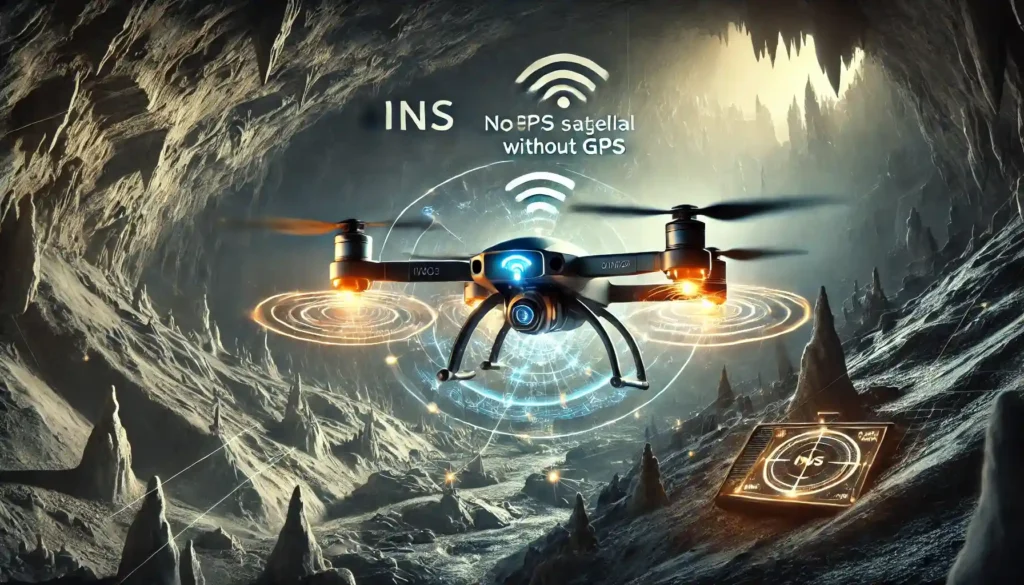Drones have revolutionized industries ranging from filmmaking to agriculture, package delivery, and even search-and-rescue missions. A key component in their operations is navigation. GPS (Global Positioning System) has long been the backbone of drone navigation, providing precise positional data to guide these flying marvels. But have you ever wondered, can a drone’s Inertial Navigation System (INS) function without GPS? Let’s dive into this fascinating question and explore how INS technology works, its independence from GPS, and the potential challenges and solutions.

What is INS?
Before jumping into the big question, let’s understand what INS is. The Inertial Navigation System (INS) is a self-contained navigation system that uses sensors to determine a vehicle’s position, velocity, and orientation. It relies on accelerometers, gyroscopes, and sometimes magnetometers to calculate motion and orientation.
INS is fundamentally different from GPS. While GPS depends on external satellite signals, INS calculates position by measuring changes in velocity and orientation from a known starting point. This independence from external signals makes INS robust against GPS signal issues, such as jamming or unavailability in GPS-denied environments.
GPS and INS: The Perfect Partnership
In most drones, GPS and INS work together. GPS provides positional accuracy, while INS fills in the gaps, especially during brief GPS outages or signal interference. This hybrid approach ensures precise and reliable navigation. However, when GPS is unavailable—say, in urban canyons, dense forests, or underground tunnels—the reliance shifts entirely to INS.
But can INS handle the responsibility on its own? The answer isn’t a straightforward yes or no. It depends on various factors, such as the quality of the INS, the drone’s mission requirements, and the duration of GPS unavailability.
Can INS Operate Without GPS?
Yes, a drone equipped with INS can technically operate without GPS, but there’s a catch. While INS doesn’t need external signals to calculate position, its accuracy tends to drift over time due to sensor errors. Let’s break this down:
1. Short-Term Accuracy
INS excels in short-term navigation. For brief GPS outages, it can provide accurate positional data. For example, if a drone enters a tunnel for a few minutes, the INS can guide it reliably without noticeable issues.
2. Drift Over Time
The longer a drone operates without GPS, the more errors accumulate in INS calculations. This phenomenon, known as drift, happens because even the most sophisticated sensors are prone to tiny inaccuracies. Over time, these errors add up, causing significant deviations in position and orientation.
3. Complex Missions
For missions requiring extended operation or high precision, standalone INS may struggle. For example, if a drone is surveying a vast area or performing autonomous delivery, relying solely on INS could result in navigation errors.

How Can Drones Overcome INS Drift?
Several technologies and strategies can complement INS to improve its performance in GPS-denied environments:
1. Sensor Fusion
Sensor fusion combines data from multiple sensors to improve accuracy. For instance, integrating INS with vision-based systems or lidar can help a drone maintain precise navigation without GPS. Cameras can track visual landmarks, while lidar creates 3D maps of the surroundings.
2. SLAM (Simultaneous Localization and Mapping)
SLAM is a popular technique for GPS-denied navigation. It allows drones to build a map of their environment while simultaneously determining their position within that map. By combining SLAM with INS, drones can navigate complex environments like forests, caves, or urban areas.
3. High-Quality IMUs (Inertial Measurement Units)
The quality of the INS depends largely on the IMU’s precision. High-grade IMUs with low drift rates can significantly extend the time a drone can operate without GPS. However, these systems are often expensive and require careful calibration.
4. Magnetic Field Mapping
By comparing local magnetic field data with pre-existing geomagnetic maps, drones can enhance their positional accuracy in GPS-denied areas. This technique works best in environments with distinct magnetic features.
5. Radio Beacons or Signals
In some scenarios, drones can rely on ground-based radio beacons, Wi-Fi signals, or cellular networks to aid navigation. While not a true standalone INS solution, these external signals can fill in the gaps when GPS is unavailable.
Use Cases for GPS-Free INS Operation
There are specific scenarios where INS must function without GPS, and drones can excel in these environments with the right technologies:
1. Military and Defense
Military operations often occur in GPS-denied environments due to intentional jamming or hostile conditions. In such cases, drones rely heavily on INS and other complementary systems for navigation.
2. Underground or Indoor Missions
INS is a lifeline for drones operating in mines, tunnels, or indoor environments where GPS signals cannot penetrate. By using sensor fusion and SLAM, these drones can perform inspections, deliver supplies, or map uncharted areas.
3. Search and Rescue
During disaster relief efforts, drones often encounter GPS-denied zones. INS, combined with vision systems, can guide drones through debris or collapsed structures to locate survivors.
4. Space Exploration
INS plays a critical role in extraterrestrial navigation, where GPS is unavailable. For example, Mars rovers use INS alongside visual odometry to traverse the planet’s surface.
Challenges of GPS-Free INS
While INS offers exciting possibilities, it’s not without challenges:
- Cost: High-quality IMUs and advanced sensor fusion systems can be expensive, limiting their use in consumer-grade drones.
- Complexity: Implementing robust sensor fusion algorithms requires sophisticated software and hardware integration.
- Power Consumption: Additional sensors like cameras or lidar can increase the drone’s power requirements, reducing flight time.
Environmental Factors: Vision-based systems may struggle in low-light or featureless environments, while magnetic mapping is ineffective in areas with uniform magnetic fields.
The Future of GPS-Free Navigation
The future of drone navigation is promising. As technology advances, we’re seeing significant improvements in INS capabilities, sensor fusion algorithms, and alternative navigation systems. Autonomous drones are increasingly equipped with redundant navigation methods, making them more reliable and versatile.
Developments in machine learning also play a crucial role. AI-powered drones can adapt to dynamic environments, learning to recognize landmarks or patterns that aid in navigation.
Final Thoughts
So, can a drone INS operate without GPS? The answer is yes, but with limitations. INS alone is suitable for short-term, less complex missions, but for extended or high-precision operations, it requires support from complementary technologies. The exciting part is that with advancements in sensor technology and AI, drones are becoming increasingly capable of navigating autonomously in GPS-denied environments.
Whether it’s exploring underground mines, dodging jamming signals in military missions, or mapping uncharted territories, the combination of INS and innovative navigation techniques is paving the way for a new era in drone capabilities.
Overview Table
Aspect | INS Without GPS |
Short-Term Navigation | Highly accurate; suitable for brief GPS outages. |
Long-Term Navigation | Accuracy drifts over time due to sensor errors. |
Complementary Systems | Sensor fusion, SLAM, high-quality IMUs, magnetic field mapping, radio signals. |
Key Use Cases | Military, indoor/underground missions, search-and-rescue, space exploration. |
Challenges | Cost, complexity, power consumption, environmental limitations. |
Future Trends | AI-powered navigation, quantum sensors, advanced sensor fusion techniques. |


